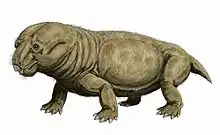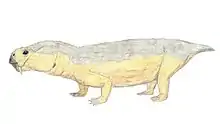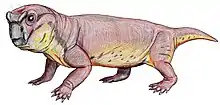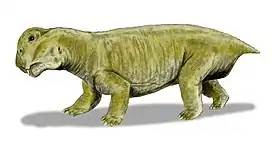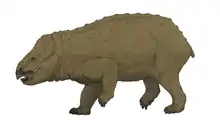Pylaecephalidae
Pylaecephalidae is a family of dicynodont therapsids that includes Diictodon, Robertia, and Prosictodon from the Permian of South Africa. Pylaecephalids were small burrowing dicynodonts with long tusks. The family was first named in 1934 and was redefined in 2009.[1] Diictodontidae and Robertiidae are considered junior synonyms of Pylaecephalidae.[2]
| Pylaecephalidae Temporal range: Permian | |
|---|---|
 | |
| Fossil of Diictodon | |
| Scientific classification | |
| Kingdom: | Animalia |
| Phylum: | Chordata |
| Clade: | Therapsida |
| Clade: | †Dicynodontia |
| Family: | †Pylaecephalidae van Hoepen, 1934 |
| Genera | |
| Synonyms | |
| |
References
- Kammerer, C.F.; Angielczyk, K.D. (2009). "A proposed higher taxonomy of anomodont therapsids" (PDF). Zootaxa. 2018: 1–24.
- Kenneth D. Angielczyk; Bruce S. Rubidge (2010). "A new pylaecephalid dicynodont (Therapsida, Anomodontia) from the Tapinocephalus Assemblage Zone, Karoo Basin, Middle Permian of South Africa". Journal of Vertebrate Paleontology. 30 (5): 1396–1409. doi:10.1080/02724634.2010.501447.
This article is issued from Wikipedia. The text is licensed under Creative Commons - Attribution - Sharealike. Additional terms may apply for the media files.

